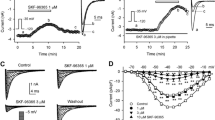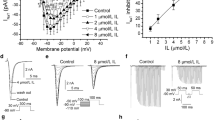Abstract
Objective
To investigate whether Suxiao Jiuxin Pills (SJP), a Chinese herbal remedy, is an anti-ventricular fibrillation (VF) agent.
Methods
VF was induced by isoproterenolol (ISO) intraperitoneal injection followed by electrical pacing in mice and rabbits. The effects of SJP on the L-type calcium channel current (CaV1.2), voltage-dependent sodium channel current (INa), rapid and slow delayed rectifier potassium channel current (IKr and IKs, respectively) were studied by whole-cell patch-clamp method. Computer simulation was implemented to incorporate the experimental data of SJP effects on the CaV1.2 current into the action potential (AP) and pseudo-electrocardiography (pseudo-ECG) models.
Results
SJP prevented VF induction and reduced VF durations significantly in mice and rabbits. Patch-clamp experiments revealed that SJP decreased the peak amplitude of the CaV1.2 current with a half maximal concentration (IC50) value of 16.9 mg/L (SJP-30 mg/L, −32.8 ± 6.1 pA; Verapamil, −16.2 ±1.8 pA; vs. control, −234.5 ±16.7 pA, P<0.01, respectively). The steady-state activation curve, inactivation curve, and the recovery from inactivation of the CaV1.2 current were not shifted significantly. Specifically, SJP did not altered INa, IKr, and IKs currents significantly (SJP vs. control, P>0.05). Computer simulation showed that SJP-reduced CaV1.2 current shortened the AP duration, transiting VF into sinus rhythm in pseudo-ECG.
Conclusion
SJP reduced VF via inhibiting the CaV1.2 current with in vivo, in vitro, and in silico studies, which provide experimental basis for SJP anti-VF clinical application.
Similar content being viewed by others
References
Tsao CW, Aday AW, Almarzooq ZI, Alonso A, Beaton AZ, Bittencourt MS, et al. Heart disease and stroke statistics-2022 Update: A report from the American Heart Association. Circulation 2022;145:e153–e639.
Bennett MT, Brown ML, Koehler J, Lexcen DR, Cheng A, Cheung JW. Trends in implantable cardioverter-defibrillator programming practices and its impact on therapies: Insights from a North American Remote Monitoring Registry 2007–2018. Heart Rhythm 2022;19:219–225.
Echt DS, Liebson PR, Mitchell LB, Peters RW, Obias-Manno D, Barker AH, et al. Mortality and morbidity in patients receiving encainide, flecainide, or placebo. The Cardiac Arrhythmia Suppression Trial. N Engl J Med 1991;324:781–788.
Duan X, Zhou L, Wu T, Liu G, Qiao J, Wei J, et al. Chinese herbal medicine suxiao jiuxin wan for angina pectoris. Cochrane Database Syst Rev 2008;2008(1):CD004473.
Lu Z, Zhang Y, Zhuang P, Zhang J, Zhou H, Zhang M, et al. Protective effect of Suxiao jiuxin pill, a traditional Chinese medicine, against acute myocardial ischemia in dogs. BMC Complement Altern Med 2015;15:373.
Guo QX, Zhang J, Li YQ, Zhang GF. Study on antiatherosclerotic effect of Suxiao Jiuxin Pill and its mechanism. Afr J Tradit Complement Altern Med 2013;11:97–102.
Bai XY, Zhang P, Yang Q, Liu XC, Wang J, Tong YL, et al. Suxiao jiuxin pill induces potent relaxation and inhibition on contraction in human artery and the mechanism. Evid Based Complement Alternat Med 2014;2014:956924.
Ren Z, Ma J, Zhang P, Luo A, Zhang S, Kong L, et al. The effect of ligustrazine on L-type calcium current, calcium transient and contractility in rabbit ventricular myocytes. J Ethnopharmacol 2012;144:555–561.
Hall AC, Turcotte CM, Betts BA, Yeung WY, Agyeman AS, Burk LA. Modulation of human GABAA and glycine receptor currents by menthol and related monoterpenoids. Eur J Pharmacol 2004;506:9–16.
Meng L, Wang HB, Deng ZQ, Wang Y, Wu JB, Lai ZY. Activation of Borneol on volume sensitive chloride channels in nasopharyngeal carcinoma cells. Chin Pharmacol Bull (Chin) 2014;30:1671–1676.
Yang HJ, Kong B, Shuai W, Zhang JJ, Huang H. Shensong Yangxin protects against metabolic syndrome-induced ventricular arrhythmias by inhibiting electrical remodeling. Front Pharmacol 2020;11:993.
Tan YF, Yu J, Pan WJ, Qi JY, Zhang MZ. Protective mechanisms of Suxiao Jiuxin Pills on myocardial ischemia-reperfusion injury in vivo and in vitro. Chin J Integr Med 2020;26:583–590.
Schwetz TA, Norring SA, Bennett ES. N-glycans modulate K(v)1.5 gating but have no effect on K(v)1.4 gating. Biochim Biophys Acta 2010;1798:367–375.
Chen FS, Fedida D. On the mechanism by which 4-Aminopyridine occludes quinidine block of the cardiac K+ channel, hKv1.5. J Gen Physiol 1998;111:539–554.
Snyders J, Knoth KM, Roberds SL, Tamkun MM. Time-, voltage-, and state-dependent block by quinidine of a cloned human cardiac potassium channel. Mol Pharmacol 1992;41:322–330.
Abderemane-Ali F, Findeisen F, Rossen ND, Minor DLJr. A selectivity filter gate controls voltage-gated calcium channel calcium-dependent Inactivation. Neuron 2019;101:1134–1149.
Splawski I, Timothy KW, Sharpe LM, Decher N, Kumar P, Bloise R, et al. Ca(V)1.2 calcium channel dysfunction causes a multisystem disorder including arrhythmia and autism. Cell 2004;119:19–31.
Splawski I, Timothy KW, Decher N, Kumar P, Sachse FB, Beggs AH, et al. Severe arrhythmia disorder caused by cardiac L-type calcium channel mutations. Proc Natl Acad Sci USA 2005;102:8089–8096
Dilmac N, Hilliard N, Hockerman GH. Molecular determinants of Ca2+ potentiation of diltiazem block and Ca2+-dependent inactivation in the pore region of cav1.2. Mol Pharmacol 2003;64:491–501.
Bennett ES. Effects of channel cytoplasmic regions on the activation mechanisms of cardiac versus skeletal muscle Na(+) channels. Biophys J 1999;77:2999–3009.
Norring SA, Ednie AR, Schwetz TA, Du D, Yang H, Bennett ES. Channel sialic acids limit hERG channel activity during the ventricular action potential. FASEB J 2013;27:622–631.
Cheng H, Zhang Y, Du C, Dempsey CE, Hancox JC. High potency inhibition of hERG potassium channels by the sodium-calcium exchange inhibitor KB-R7943. Br J Pharmacol 2012;165:2260–2273.
Caballero R, Moreno I, González T, Arias C, Valenzuela C, Delpón E, et al. Spironolactone and its main metabolite, canrenoic acid, block human ether-a-go-go-related gene channels. Circulation 2003;107:889–895.
Sun DD, Wang HC, Wang XB, Luo Y, Jin ZX, Li ZC, et al. Tanshinone II A: a new activator of human cardiac KCNQ1/KCNE1 (I(Ks)) potassium channels. Eur J Pharmacol 2008;590:317–321.
Herrington J, Solaro CR, Neely A, Lingle CJ. The suppression of Ca(2+)- and voltage-dependent outward K+ current during mAChR activation in rat adrenal chromaffin cells. J Physiol 1995;485:297–318.
Lovell PV, McCobb DP. Pituitary control of BK potassium channel function and intrinsic firing properties of adrenal chromaffin cells. J Neurosci 2001;21:3429–3442.
Moreno JD, Zhu ZI, Yang PC, Bankston JR, Jeng MT, Kang C, et al. A computational model to predict the effects of class I anti-arrhythmic drugs on ventricular rhythms. Sci Transl Med 2011;3:98ra83.
Yang PC, Kurokawa J, Furukawa T, Clancy CE. Acute effects of sex steroid hormones on susceptibility to cardiac arrhythmias: a simulation study. PLoS Comput Biol 2010;6:e1000658.
Hool LC. Hypoxia increases the sensitivity of the L-type Ca(2+) current to beta-adrenergic receptor stimulation via a C2 region-containing protein kinase C isoform. Circ Res 2000;87:1164–1171.
Gaur N, Rudy Y, Hool L. Contributions of ion channel currents to ventricular action potential changes and induction of early afterdepolarizations during acute hypoxia. Circ Res 2009;105:1196–1203.
Gima K, Rudy Y. Ionic current basis of electrocardiographic waveforms: a model study. Circ Res 2002;90:889–896.
Elayi CS, Charnigo RJ, Heron PM, Lee BK, Olgin JE. Primary prevention of sudden cardiac death early post-myocardial infarction: root cause analysis for Implantable cardioverter-defibrillator failure and currently available options. Circ Arrhythm Electrophysiol 2017;10:e005194.
Sendfeld F, Selga E, Scornik FS, Pérez GJ, Mills NL, Brugada R. Experimental models of Brugada syndrome. Int J Mol Sci 2019;20:2123.
Sattler SM, Skibsbye L, Linz D, Lubberding AF, Tfelt-Hansen J, Jespersen T. Ventricular arrhythmias in first acute myocardial infarction: epidemiology, mechanisms, and interventions in large animal models. Front Cardiovasc Med 2019;6:158.
Hwang J, Kim TY, Terentyev D, Zhong M, Kabakov AY, Bronk P, et al. Late INa blocker GS967 supresses polymorphic ventricular tachycardia in a transgenic rabbit model of long QT type 2. Circ Arrhythm Electrophysiol 2020;13:e006875.
Schwartz PJ, Ackerman MJ, Antzelevitch C, Bezzina CR, Borggrefe M, Cuneo BF, et al. Inherited cardiac arrhythmias. Nat Rev Dis Primers 2020;6:58.
Glaaser IW, Kass RS, Clancy CE. Mechanisms of genetic arrhythmias: from DNA to ECG. Prog Cardiovasc Dis 2003;46:259–270.
Johnson EK, Springer SJ, Wang W, Dranoff EJ, Zhang Y, Kanter EM, et al. Differentiate expression and remodeling of transient outward potassium currents in human left ventricles. Circ Arrhythm Electrophysiol 2018;11:e005914.
Author information
Authors and Affiliations
Contributions
Zhang MZ designed the study and provided valuable suggestions and comments on the study design. Kang DY and Yu J performed the experiments. Qi JY prepared all Figures, analyzed the results, and wrote the paper. All authors contributed to the article and approved the manuscript submission.
Corresponding author
Additional information
Conflict of Interest
No conflict of interests, financial or otherwise, are declared.
Supported by the National Natural Science Foundation of Guangdong (No. 2020A1515010777)
Rights and permissions
About this article
Cite this article
Qi, Jy., Kang, Dy., Yu, J. et al. Suxiao Jiuxin Pills Prevent Ventricular Fibrillation from Inhibiting L-type Calcium Currents CaV1.2 in vivo and in vitro. Chin. J. Integr. Med. 29, 108–118 (2023). https://doi.org/10.1007/s11655-022-3623-7
Accepted:
Published:
Issue Date:
DOI: https://doi.org/10.1007/s11655-022-3623-7




